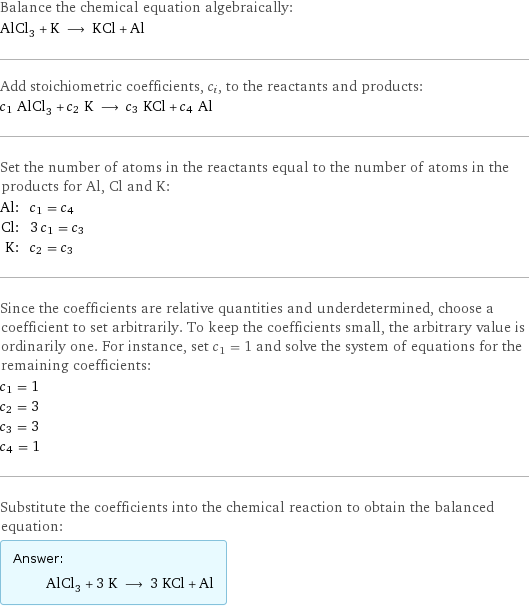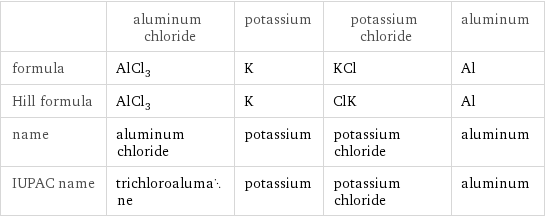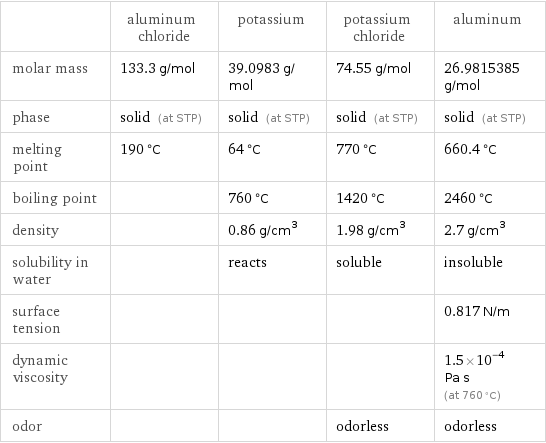Input interpretation

AlCl_3 aluminum chloride + K potassium ⟶ KCl potassium chloride + Al aluminum
Balanced equation

Balance the chemical equation algebraically: AlCl_3 + K ⟶ KCl + Al Add stoichiometric coefficients, c_i, to the reactants and products: c_1 AlCl_3 + c_2 K ⟶ c_3 KCl + c_4 Al Set the number of atoms in the reactants equal to the number of atoms in the products for Al, Cl and K: Al: | c_1 = c_4 Cl: | 3 c_1 = c_3 K: | c_2 = c_3 Since the coefficients are relative quantities and underdetermined, choose a coefficient to set arbitrarily. To keep the coefficients small, the arbitrary value is ordinarily one. For instance, set c_1 = 1 and solve the system of equations for the remaining coefficients: c_1 = 1 c_2 = 3 c_3 = 3 c_4 = 1 Substitute the coefficients into the chemical reaction to obtain the balanced equation: Answer: | | AlCl_3 + 3 K ⟶ 3 KCl + Al
Structures

+ ⟶ +
Names

aluminum chloride + potassium ⟶ potassium chloride + aluminum
Reaction thermodynamics
Entropy

| aluminum chloride | potassium | potassium chloride | aluminum molecular entropy | 111 J/(mol K) | 64 J/(mol K) | 83 J/(mol K) | 28.3 J/(mol K) total entropy | 111 J/(mol K) | 192 J/(mol K) | 249 J/(mol K) | 28.3 J/(mol K) | S_initial = 303 J/(mol K) | | S_final = 277.3 J/(mol K) | ΔS_rxn^0 | 277.3 J/(mol K) - 303 J/(mol K) = -25.7 J/(mol K) (exoentropic) | | |
Equilibrium constant
![Construct the equilibrium constant, K, expression for: AlCl_3 + K ⟶ KCl + Al Plan: • Balance the chemical equation. • Determine the stoichiometric numbers. • Assemble the activity expression for each chemical species. • Use the activity expressions to build the equilibrium constant expression. Write the balanced chemical equation: AlCl_3 + 3 K ⟶ 3 KCl + Al Assign stoichiometric numbers, ν_i, using the stoichiometric coefficients, c_i, from the balanced chemical equation in the following manner: ν_i = -c_i for reactants and ν_i = c_i for products: chemical species | c_i | ν_i AlCl_3 | 1 | -1 K | 3 | -3 KCl | 3 | 3 Al | 1 | 1 Assemble the activity expressions accounting for the state of matter and ν_i: chemical species | c_i | ν_i | activity expression AlCl_3 | 1 | -1 | ([AlCl3])^(-1) K | 3 | -3 | ([K])^(-3) KCl | 3 | 3 | ([KCl])^3 Al | 1 | 1 | [Al] The equilibrium constant symbol in the concentration basis is: K_c Mulitply the activity expressions to arrive at the K_c expression: Answer: | | K_c = ([AlCl3])^(-1) ([K])^(-3) ([KCl])^3 [Al] = (([KCl])^3 [Al])/([AlCl3] ([K])^3)](../image_source/1aeb87088b7e0dd2ad09df1f4e73dbcd.png)
Construct the equilibrium constant, K, expression for: AlCl_3 + K ⟶ KCl + Al Plan: • Balance the chemical equation. • Determine the stoichiometric numbers. • Assemble the activity expression for each chemical species. • Use the activity expressions to build the equilibrium constant expression. Write the balanced chemical equation: AlCl_3 + 3 K ⟶ 3 KCl + Al Assign stoichiometric numbers, ν_i, using the stoichiometric coefficients, c_i, from the balanced chemical equation in the following manner: ν_i = -c_i for reactants and ν_i = c_i for products: chemical species | c_i | ν_i AlCl_3 | 1 | -1 K | 3 | -3 KCl | 3 | 3 Al | 1 | 1 Assemble the activity expressions accounting for the state of matter and ν_i: chemical species | c_i | ν_i | activity expression AlCl_3 | 1 | -1 | ([AlCl3])^(-1) K | 3 | -3 | ([K])^(-3) KCl | 3 | 3 | ([KCl])^3 Al | 1 | 1 | [Al] The equilibrium constant symbol in the concentration basis is: K_c Mulitply the activity expressions to arrive at the K_c expression: Answer: | | K_c = ([AlCl3])^(-1) ([K])^(-3) ([KCl])^3 [Al] = (([KCl])^3 [Al])/([AlCl3] ([K])^3)
Rate of reaction
![Construct the rate of reaction expression for: AlCl_3 + K ⟶ KCl + Al Plan: • Balance the chemical equation. • Determine the stoichiometric numbers. • Assemble the rate term for each chemical species. • Write the rate of reaction expression. Write the balanced chemical equation: AlCl_3 + 3 K ⟶ 3 KCl + Al Assign stoichiometric numbers, ν_i, using the stoichiometric coefficients, c_i, from the balanced chemical equation in the following manner: ν_i = -c_i for reactants and ν_i = c_i for products: chemical species | c_i | ν_i AlCl_3 | 1 | -1 K | 3 | -3 KCl | 3 | 3 Al | 1 | 1 The rate term for each chemical species, B_i, is 1/ν_i(Δ[B_i])/(Δt) where [B_i] is the amount concentration and t is time: chemical species | c_i | ν_i | rate term AlCl_3 | 1 | -1 | -(Δ[AlCl3])/(Δt) K | 3 | -3 | -1/3 (Δ[K])/(Δt) KCl | 3 | 3 | 1/3 (Δ[KCl])/(Δt) Al | 1 | 1 | (Δ[Al])/(Δt) (for infinitesimal rate of change, replace Δ with d) Set the rate terms equal to each other to arrive at the rate expression: Answer: | | rate = -(Δ[AlCl3])/(Δt) = -1/3 (Δ[K])/(Δt) = 1/3 (Δ[KCl])/(Δt) = (Δ[Al])/(Δt) (assuming constant volume and no accumulation of intermediates or side products)](../image_source/f2e6227059b61c867e55994855c05b16.png)
Construct the rate of reaction expression for: AlCl_3 + K ⟶ KCl + Al Plan: • Balance the chemical equation. • Determine the stoichiometric numbers. • Assemble the rate term for each chemical species. • Write the rate of reaction expression. Write the balanced chemical equation: AlCl_3 + 3 K ⟶ 3 KCl + Al Assign stoichiometric numbers, ν_i, using the stoichiometric coefficients, c_i, from the balanced chemical equation in the following manner: ν_i = -c_i for reactants and ν_i = c_i for products: chemical species | c_i | ν_i AlCl_3 | 1 | -1 K | 3 | -3 KCl | 3 | 3 Al | 1 | 1 The rate term for each chemical species, B_i, is 1/ν_i(Δ[B_i])/(Δt) where [B_i] is the amount concentration and t is time: chemical species | c_i | ν_i | rate term AlCl_3 | 1 | -1 | -(Δ[AlCl3])/(Δt) K | 3 | -3 | -1/3 (Δ[K])/(Δt) KCl | 3 | 3 | 1/3 (Δ[KCl])/(Δt) Al | 1 | 1 | (Δ[Al])/(Δt) (for infinitesimal rate of change, replace Δ with d) Set the rate terms equal to each other to arrive at the rate expression: Answer: | | rate = -(Δ[AlCl3])/(Δt) = -1/3 (Δ[K])/(Δt) = 1/3 (Δ[KCl])/(Δt) = (Δ[Al])/(Δt) (assuming constant volume and no accumulation of intermediates or side products)
Chemical names and formulas

| aluminum chloride | potassium | potassium chloride | aluminum formula | AlCl_3 | K | KCl | Al Hill formula | AlCl_3 | K | ClK | Al name | aluminum chloride | potassium | potassium chloride | aluminum IUPAC name | trichloroalumane | potassium | potassium chloride | aluminum
Substance properties

| aluminum chloride | potassium | potassium chloride | aluminum molar mass | 133.3 g/mol | 39.0983 g/mol | 74.55 g/mol | 26.9815385 g/mol phase | solid (at STP) | solid (at STP) | solid (at STP) | solid (at STP) melting point | 190 °C | 64 °C | 770 °C | 660.4 °C boiling point | | 760 °C | 1420 °C | 2460 °C density | | 0.86 g/cm^3 | 1.98 g/cm^3 | 2.7 g/cm^3 solubility in water | | reacts | soluble | insoluble surface tension | | | | 0.817 N/m dynamic viscosity | | | | 1.5×10^-4 Pa s (at 760 °C) odor | | | odorless | odorless
Units
